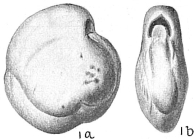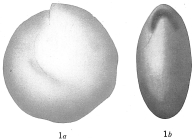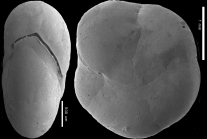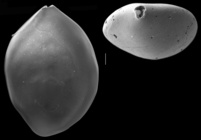
| Intro | | About | | Wiki | | Search traits | | Data explorer | | Literature | | Definitions | | Sources | | Webservices | | Statistics | | Feedback | | Editors | | Log in |
WoRMS taxon detailsNummoloculina Steinmann, 1881
112030 (urn:lsid:marinespecies.org:taxname:112030)
accepted
Genus
Biloculina contraria d'Orbigny, 1846 accepted as Nummoloculina contraria (d'Orbigny, 1846) (type by original designation)
Nummoculina · unaccepted
marine,
feminine
Steinmann, G. (1881), Die Foraminiferengattung Nummoloculina n. g., Neues Jahrbuch für Mineralogie, Geologie, und Palaeontologie 1:31-43. , available online at https://biodiversitylibrary.org/page/44132855
page(s): p. 31 [details]
Hayward, B.W.; Le Coze, F.; Vachard, D.; Gross, O. (2025). World Foraminifera Database. Nummoloculina Steinmann, 1881. Accessed through: World Register of Marine Species at: https://marinespecies.org/aphia.php?p=taxdetails&id=112030 on 2025-05-22
Date action by 2006-09-26 06:56:50Z changed Martinez, Olga
Nomenclatureoriginal description
Steinmann, G. (1881), Die Foraminiferengattung Nummoloculina n. g., Neues Jahrbuch für Mineralogie, Geologie, und Palaeontologie 1:31-43. , available online at https://biodiversitylibrary.org/page/44132855 page(s): p. 31 [details] basis of record Gross, O. (2001). Foraminifera, <B><I>in</I></B>: Costello, M.J. <i>et al.</i> (Ed.) (2001). <i>European register of marine species: a check-list of the marine species in Europe and a bibliography of guides to their identification. Collection Patrimoines Naturels,</i> 50: pp. 60-75 (look up in IMIS) [details] Othercontext source (Deepsea)
Murray, J.W. (2006). Ecology and applications of benthic foraminifera. <em>Cambridge, UK, Cambridge University Press.</em> 426pp., available online at http://www.cambridge.org/9780521828390 [details] Available for editors
additional source Neave, Sheffield Airey. (1939-1996). Nomenclator Zoologicus vol. 1-10 Online. <em>[Online Nomenclator Zoologicus at Checklistbank. Ubio link has gone].</em> , available online at https://www.checklistbank.org/dataset/126539/about [details] additional source Loeblich, A. R.; Tappan, H. (1987). Foraminiferal Genera and their Classification. Van Nostrand Reinhold Company, New York. 970pp., available online at https://books.google.pt/books?id=n_BqCQAAQBAJ [details] Available for editors  Present Present  Inaccurate Inaccurate  Introduced: alien Introduced: alien  Containing type locality Containing type locality
From editor or global species database
Diagnosis Test ovate in outline, discoidal to biconvex, periphery broadly rounded, with two rapidly enlarging chambers per whorl added in planes less than 180¡ apart to result in an early sigmoid arrangement as seen in section, later with up to five chambers per whorl added in a single plane, lateral wall extensions from each chamber overlap the umbilical region and entirely cover the earliest chambers but do not completely cover the peripheral region of the penultimate chamber, thus sectioned specimens with three to five chambers per whorl show an equal number of lamellae per whorl; wall thick, calcareous, imperforate, porcelaneous, surface smooth and polished; aperture large, semicircular to subtriangular at the end of the final chamber, with a distinct broad flap. M. Miocene (Tortonian) to Holocene; Europe; Atlantic; Pacific. (Loeblich & Tappan, 1987, Foraminiferal Genera and Their Classification) [details]
|





